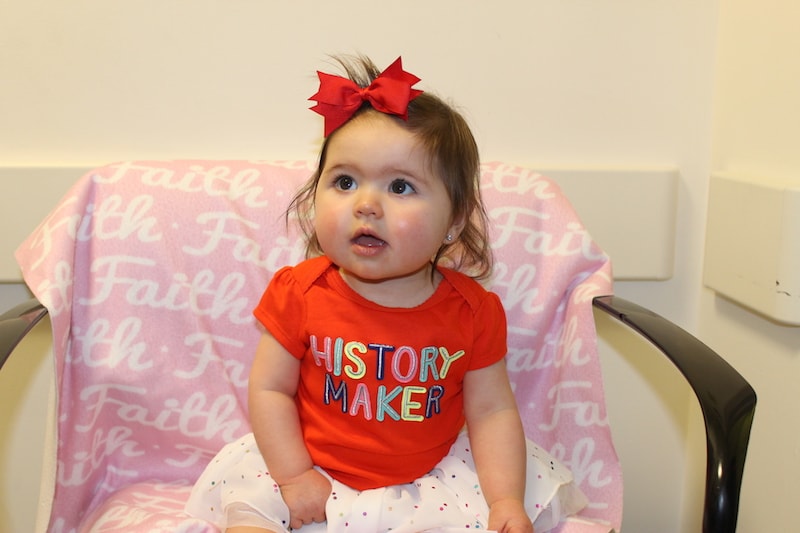Having Faith: A novel approach to heart surgery

When Rachel and Rudy Fasano of New Haven, Connecticut learned they were having their first baby after three years of trying, they were overjoyed, as were their families. At Rachel’s 15-week ultrasound to learn their baby’s sex, both grandmothers were also in tow, eager to hear the news. But the visit delivered some unexpected results.
“The tech told us the baby was a girl and everything was looking great,” says Rachel. “Then she got kind of quiet looking at the pictures. When she asked our mothers if she could speak with us alone for a minute, we knew something wasn’t right.”
A ‘shuffled’ heart
The tech told them something seemed amiss with their baby’s heart and recommended a level 2 ultrasound at a local hospital. A few weeks later, that ultrasound revealed her heart wasn’t developing properly. She was diagnosed with tricuspid atresia, pulmonary atresia, dextrocardia and an unformed right ventricle.

“They said she would need specialized heart care and we should choose which hospital we wanted to use,” says Rachel. “Everyone down here told us Boston Children’s Hospital was the best, so that’s where we decided to go.”
Two weeks later, they met with Dr. Rahul Rathod, a cardiologist at Boston Children’s and director of the Single Ventricle Heart Program.
Rathod diagnosed their baby with pulmonary atresia, a condition in which the pulmonary valve in the heart doesn’t form correctly. He explained she would need three surgeries after birth to create single ventricle circulation. This allows both ventricles in the heart to function as a single pump to the body. He would monitor the baby’s progress throughout Rachel’s pregnancy and they would deliver the baby in Boston.
First chance at new study
At one of their visits about halfway through Rachel’s pregnancy, Rathod mentioned a new study they might be eligible for. It would use their baby’s own umbilical vein to create the shunt needed for her first surgery, shortly after birth. When they expressed interest, Rathod introduced them to Dr. David Hoganson, a cardiac surgeon at Boston Children’s and co-leader of the study.
“Dr. Hoganson met with us and explained that by using the baby’s umbilical vein, it would potentially reduce the chance of narrowing and clotting that comes with the man-made BT shunt they typically use for the surgery,” says Rudy.
The Fasanos understood there were no guarantees — their baby would be the first to have the new umbilical shunt, but it was a chance they were willing to take.
“Since clotting is the biggest risk after the first surgery, it made a lot of sense to us, and it made us feel more comfortable knowing they were using her own body part,” says Rudy.
Meeting Faith and a successful surgery
Faith was born on June 20, 2017. The doctors took her umbilical vein and brought Faith across the bridge to Boston Children’s. Two days later, she had her first surgery to place the shunt.
A few weeks later, Rachel and Rudy left the hospital with their new baby. “We felt a lot more comfortable going home knowing she had the umbilical vein shunt,” says Rudy. “The biggest risk of mortality between the first and second surgeries is clotting, and her umbilical shunt reduced that risk, so we had a lot more peace of mind during this fragile time.”
While they waited for Faith’s next surgery, they saw an in-home nurse once a week and closely monitored her weight and blood oxygen levels.

At 4 months old, Faith had her second surgery. Hoganson removed her umbilical shunt and placed a Glenn shunt. It all went off without a hitch. Today, Faith is a happy, high-energy 1-year-old. She continues to be monitored by Rathod, and also sees a local cardiologist near her home in Connecticut. When she is a little older — around age 2 or 3 — she will have her third heart surgery.
“You would never know she’s had heart surgery. She’s the happiest kid and hasn’t even hasn’t even caught a cold,” says Rudy. “And Drs. Hoganson and Rathod have been amazing. They treat her like family. We would definitely recommend the umbilical cord shunt for anyone.”
Learn more about our Fetal Cardiology Program.
Related Posts :
-

Four things you should know about MAPCAs treatment
As the first grandchild in her family, Hannah Homan is in demand for frequent visits. She was also the focus ...
-

Treating MAPCAs with unifocalization surgery and cardiology care
Children born with a rare form of tetralogy of Fallot (ToF) face a challenging type of congenital heart ...
-

After surgeries to treat HLHS, Carter is healthy and happy at home in Florida
Carter Miller loves action. The 4-year-old Florida resident enjoys riding on golf carts and flying high on swing sets. ...
-

Advancing global health: Using AI to detect heart disease in children
In many low- and middle-income countries, pediatric cardiologists can’t help children with congenital heart conditions because of a critical ...





